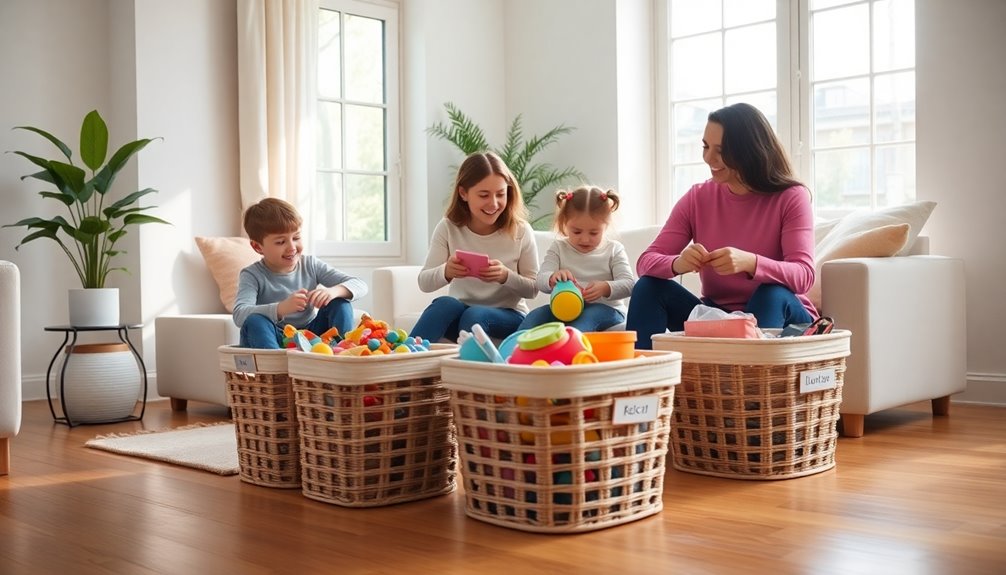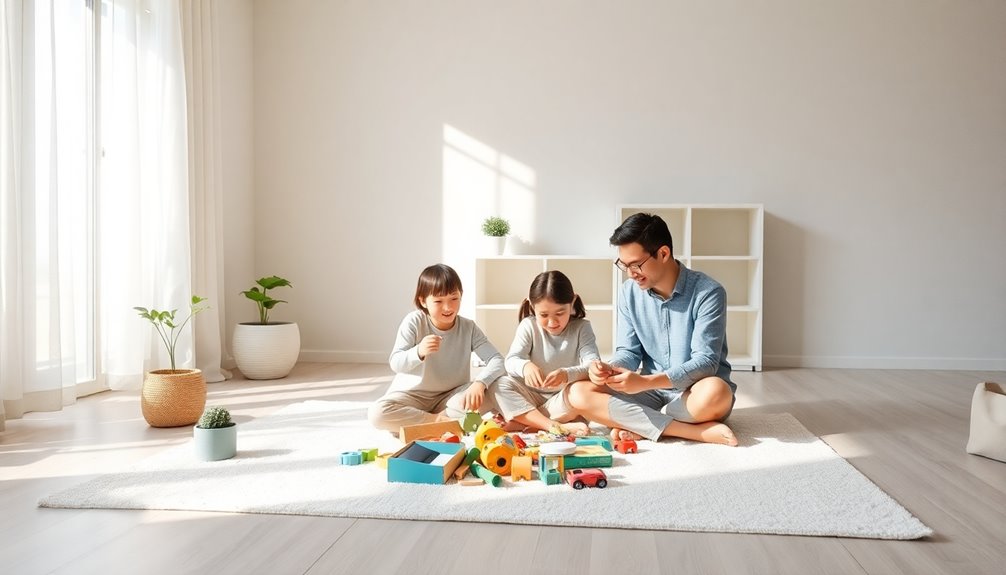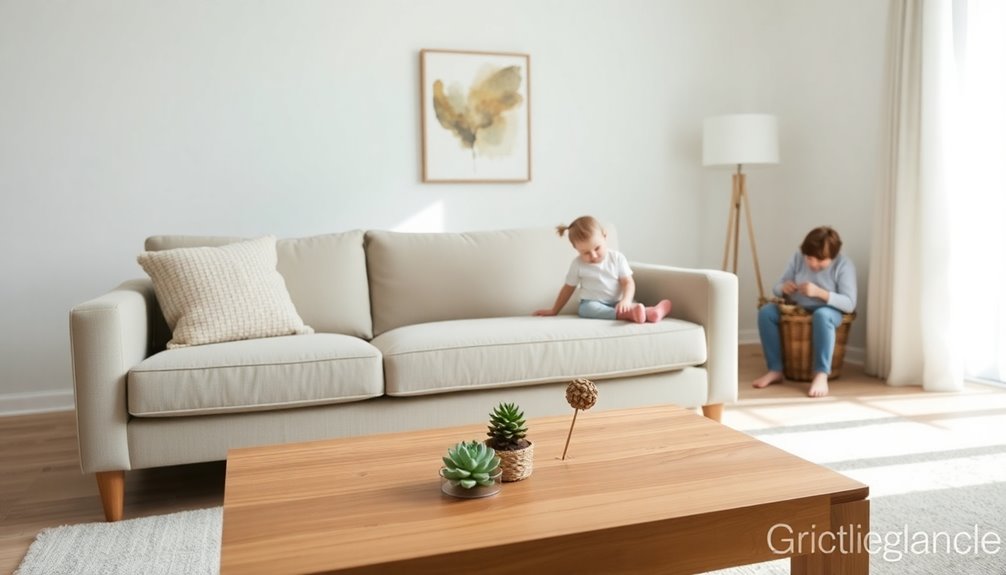Embracing minimalism as a family creates a clutter-free home that enhances your relationships and emotional well-being. It teaches kids financial literacy and the value of experiences over things. You can involve everyone by sorting belongings together, setting up a donation station, or creating fun challenges. Encourage thoughtful purchasing and establish a "one in, one out" rule to keep clutter at bay. Discover more strategies for overcoming challenges and fostering a joyful, minimalist lifestyle together.
Key Takeaways
- Involve the entire family in decluttering by setting aside dedicated time for sorting and organizing belongings together.
- Create a family donation station to encourage everyone to contribute items they no longer need.
- Implement a "one in, one out" rule to manage new purchases and prevent clutter accumulation.
- Focus on experiences over material possessions by prioritizing quality family activities that foster connection.
- Regularly assess belongings together, teaching kids the importance of mindful spending and organization.
Understanding the Benefits of Minimalism for Families

Minimalism can transform family life in meaningful ways.
As a minimalist family, you'll create a clutter-free home that fosters financial literacy and teaches your kids about mindful spending. By prioritizing experiences over possessions, you'll strengthen your relationships through shared activities, making lasting memories instead of accumulating toys.
This intentional living approach helps you declutter not just your space, but your minds, leading to significant stress reduction. Focusing on what truly matters allows you to define your values together, eliminating distractions that often cause anxiety. Emotional and psychological growth is enhanced through this process, promoting healthier family dynamics.
Research shows that modern parenting can be overwhelming, but embracing minimalism promotes mental well-being for everyone. By simplifying life, you'll find more joy in each other's company and cultivate an environment where love thrives.
Steps to Involve the Whole Family in Decluttering

When you involve the whole family in the decluttering process, it becomes a shared journey that strengthens bonds and fosters commitment. Set aside specific time for sorting together and discuss the benefits of minimalism.
Create a family donation station to encourage sharing and generosity by making it easy for everyone to contribute items they no longer need. Motivate your kids by using a printable challenge that turns decluttering into a fun activity.
Establish a family donation station to inspire generosity and make decluttering a fun, engaging challenge for everyone.
Start with adult belongings to set a positive example, showing the value of having less stuff. As you achieve milestones, celebrate with family activities or rewards, reinforcing positive behavior and creating lasting memories while simplifying your physical space.
Embracing the art of decluttering can lead to not only a more organized home but also enhanced emotional well-being for the entire family.
Embrace this journey together!
Thoughtful Purchasing: Managing Belongings Together

As your family embraces the decluttering journey, it's important to approach future purchases with intention. Encourage your kids to ask themselves, "Do I need this?" instead of "Do I want this?" This mindset fosters a minimalist approach, focusing on necessity. Implement a "one in, one out" rule—when a new item enters your home, another should be donated or discarded. Regularly assess toys and clothing together to help family members understand their belongings better. Make sure to communicate gift preferences to relatives, balancing the joy of receiving with your goal to go minimalist. Finally, create designated spaces for each child's belongings, making it easier to track and manage what they own. Additionally, teaching children the value of financial planning can help them appreciate the importance of mindful spending as they grow.
| Action | Purpose |
|---|---|
| Ask "Do I need this?" | Fosters necessity over desire |
| One in, one out | Controls clutter |
| Assess belongings | Involves kids in decluttering |
| Communicate preferences | Aligns gifts with values |
| Designated spaces | Maintains organization |
Fostering a Mindset of Experiences Over Things

Shifting your family's focus from material possessions to shared experiences can create deeper connections and lasting memories. Kids need quality time and good stuff that enriches their lives, like time outdoors and shared hobbies.
Embracing minimalism to reduce clutter allows you to prioritize these experiences over toys. Encourage your children to engage in activities that require little equipment, fostering an appreciation for simple pleasures.
Discussing the importance of donating belongings teaches generosity and empathy, reinforcing family connections. Sharing a room or enjoying a picnic can deepen bonds while practicing intentional living. Additionally, engaging in activities like pet therapy can enhance emotional well-being and create lasting memories as a family.
Overcoming Challenges in the Minimalist Journey Together

Embracing minimalism as a family can be challenging, especially when you're juggling busy schedules and differing opinions on what to keep.
Time constraints often hinder your decluttering efforts, but setting aside specific moments for this task can make a difference. To get everyone on board, maintain open communication about your goals and involve the whole family in the process.
With young kids, focus on small steps to avoid feelings of overwhelm. Start by getting rid of items that don't add value to your lives. Additionally, establishing digital boundaries can help create a clutter-free environment both physically and online.
Frequently Asked Questions
What Is the 90 90 Rule for Minimalism?
The 90/90 Rule for minimalism helps you evaluate your possessions by asking if you've used an item in the past 90 days or if you'll use it in the next 90 days.
If the answer's no, it's probably time to let it go. This rule streamlines decluttering and encourages you to be intentional about what you keep, fostering a more organized and functional living space while promoting mindful purchasing habits.
What Is the 20/20 Rule in Minimalism?
Imagine your living space, cluttered with items that gather dust instead of joy.
The 20/20 Rule helps you clear that chaos. If you can replace an item for $20 or less and find it within 20 minutes, it's likely not worth keeping.
What Is the 30/30 Rule for Minimalists?
The 30/30 Rule for minimalists is a straightforward decluttering strategy you can use.
It involves identifying items you haven't used in the last 30 days. If you don't see yourself using them in the next 30 days, it's time to decide whether to keep, donate, or sell them.
This method helps you make quick decisions, reduces clutter, and encourages you to think about the value of your possessions while maintaining a clutter-free space.
How to Live Minimally With a Family?
To live minimally with your family, start by decluttering your own belongings before tackling shared spaces.
Focus on unused items and implement a "one in, one out" rule to control new purchases.
Get your kids involved in deciding what to keep or donate, helping them understand minimalism.
Prioritize experiences over material goods, creating lasting memories together.
Regularly assess what you own and engage in family discussions about your values to maintain a clutter-free lifestyle.
Conclusion
As you commence this minimalist journey together, remember the joy of shared moments over material possessions. Just like the story of the Little Prince, who discovered that what truly matters is invisible to the eye, you'll find deeper connections within your family. Embrace the simplicity, create lasting memories, and watch your home transform into a sanctuary of love and laughter. Together, you'll not only declutter your space but also enrich your lives with experiences that truly matter.









